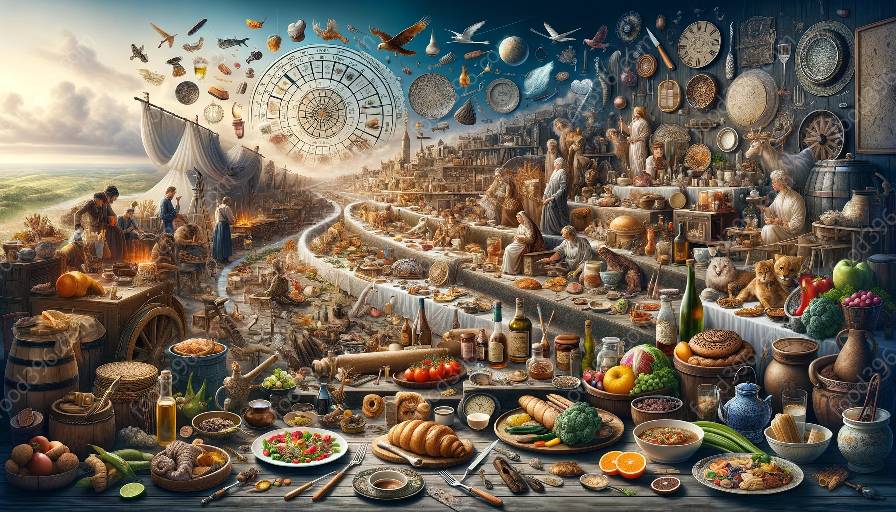Mexican regional cuisines offer a rich tapestry of flavors and techniques, each with a unique history and cultural significance. The development of these culinary traditions is deeply intertwined with the history of Mexico and its diverse cultural influences. This comprehensive exploration of Mexican regional cuisines will delve into their origins, key ingredients, traditional dishes, and their compatibility with the broader history of Mexican cuisine and global culinary traditions.
Origins and Diverse Influences
The development of Mexican regional cuisines can be traced back to pre-Columbian times, where indigenous communities cultivated an array of ingredients that would later become staple elements in Mexican cuisine. Maize, beans, chilies, tomatoes, avocados, and more played a central role in the culinary heritage of Mexico, and their cultivation and consumption varied across regions.
Following the Spanish conquest in the 16th century, European ingredients and cooking techniques were introduced, blending with indigenous culinary traditions to create a unique fusion of flavors. The subsequent influence of African, Caribbean, and Asian cultures further enriched the Mexican culinary landscape, resulting in a diverse range of regional cuisines characterized by distinct ingredients, flavors, and cooking methods.
Regional Diversity in Mexican Cuisine
Mexico's vast and varied landscape has contributed to the development of distinct regional cuisines, each showcasing the local ingredients and culinary practices of its specific area. From the seafood-rich coastal regions to the rugged and mountainous interior, Mexican cuisine reflects the cultural and agricultural diversity found throughout the country.
For example, the coastal regions, such as the Yucatán Peninsula, are known for their emphasis on seafood, tropical fruits, and unique spice blends influenced by Mayan, Caribbean, and European traditions. In contrast, the central region, including Mexico City and its surroundings, is celebrated for its use of corn-based dishes, traditional moles, and an array of street foods that provide a glimpse into the city's vibrant culinary heritage.
The northern regions bordering the United States boast a culinary landscape heavily influenced by ranching and cowboy culture, with dishes featuring beef, cheese, and wheat-based products. The Pacific coast regions feature an abundance of fresh seafood utilized in ceviches, seafood stews, and coastal-inspired dishes. In contrast, the southern states, such as Oaxaca and Chiapas, are renowned for their complex moles, tamales, and vibrant indigenous culinary traditions.
Key Ingredients and Traditional Dishes
The development of Mexican regional cuisines is exemplified through the use of signature ingredients and the creation of traditional dishes that have come to define each region's culinary identity. From the aromatic spices of Yucatán to the bold chilies of the central highlands, each region showcases its unique flavors.
For example, the Yucatán Peninsula is famed for its use of achiote, a vibrant red spice derived from the annatto seed, which lends its distinct color and flavor to dishes such as cochinita pibil, a traditional slow-roasted pork dish. In the central region, the rich and complex moles of Puebla and Oaxaca demonstrate the meticulous preparation and layering of ingredients that have been cultivated over centuries, resulting in dishes such as mole poblano and mole negro.
The northern regions showcase hearty dishes such as carne asada, a beloved grilled beef dish, and gorditas, thick corn cakes stuffed with various fillings. In contrast, the coastal regions offer an abundance of seafood-based dishes such as ceviche, aguachile, and pescado a la veracruzana, highlighting the bounty of the Pacific and Gulf of Mexico.
Compatibility with Mexican Cuisine History and Global Culinary Traditions
The development of Mexican regional cuisines is deeply rooted in the broader history of Mexican cuisine, reflecting the fusion of indigenous, European, African, and Asian influences over centuries. This amalgamation of culinary traditions has led to the creation of a diverse and vibrant food culture that continues to evolve and innovate.
Furthermore, the compatibility of Mexican regional cuisines with global culinary traditions is evident in the widespread popularity and influence of dishes such as tacos, tamales, and salsas, which have transcended borders and gained recognition on the international culinary stage. The vibrant flavors, diverse ingredients, and rich cultural heritage of Mexican regional cuisines have contributed to the global appeal and appreciation of Mexican cuisine as a whole.
Overall, the development of Mexican regional cuisines offers a profound insight into the cultural, historical, and agricultural diversity of Mexico, showcasing the enduring legacy of traditional ingredients, cooking techniques, and distinctive flavors that continue to shape the culinary landscape of the region.

